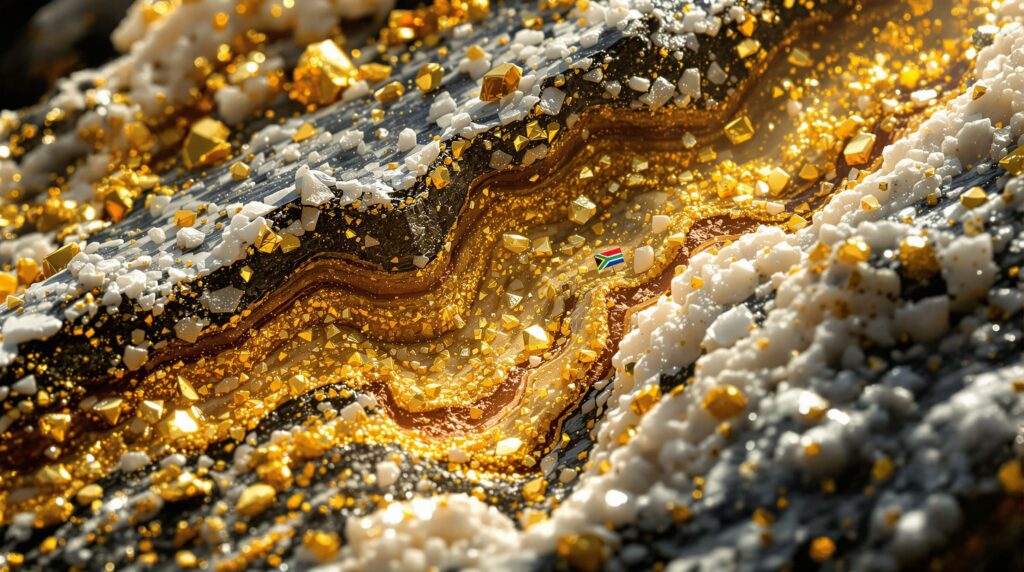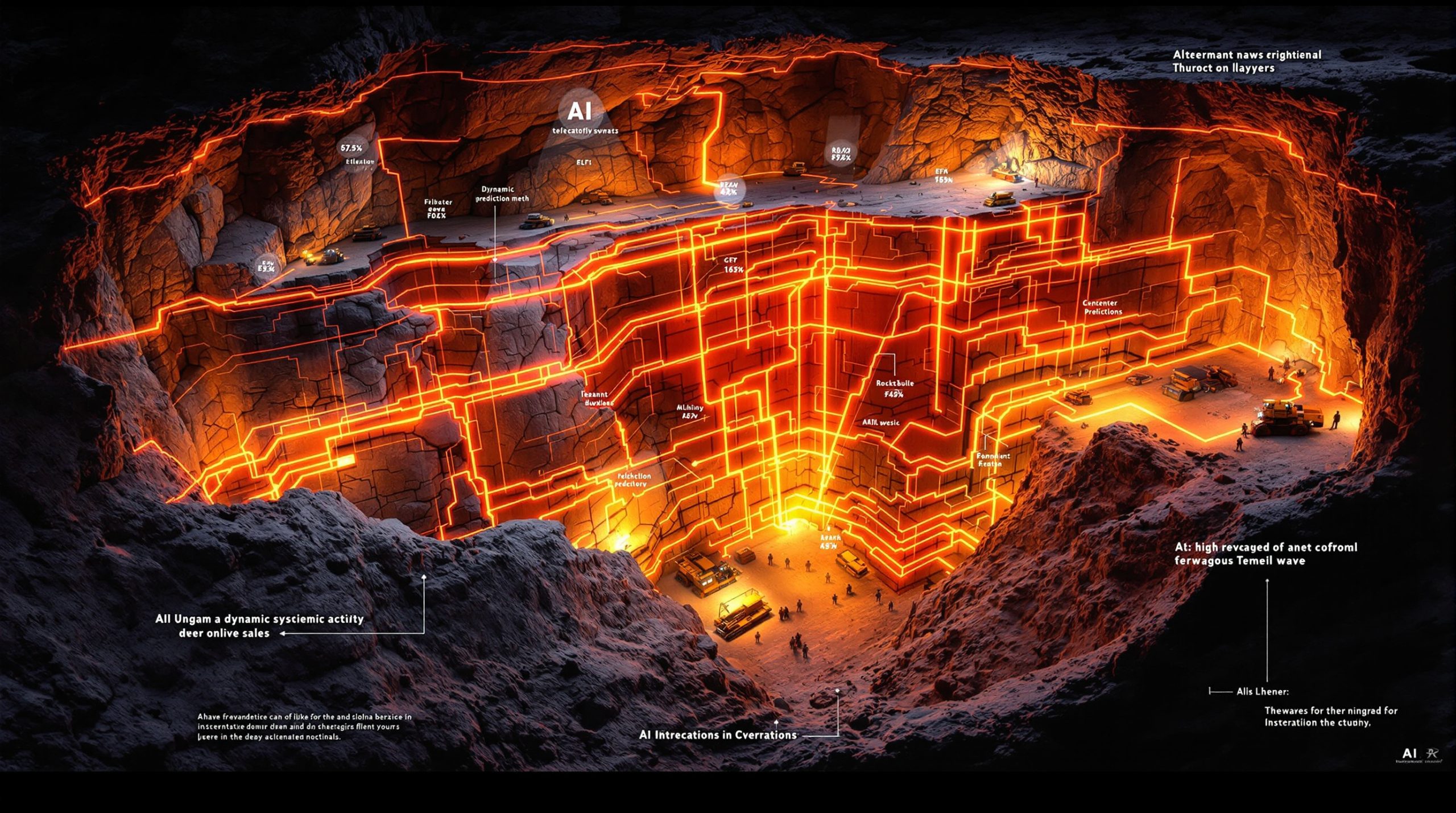What Are Gold-Bearing Conglomerates?
Gold-bearing conglomerates are unique sedimentary rock formations that contain gold particles embedded within a matrix of rounded clasts. These geological wonders represent some of Earth's most economically significant mineral deposits, particularly in South Africa's Witwatersrand Basin.
Definition and Composition
Gold-bearing conglomerates consist primarily of quartz pebbles and other durable minerals ranging from fine gravel to cobble size. The spaces between these larger particles are filled with finer materials—sand, silt, and clay—all cemented together by silica, iron oxides, or carbonate minerals.
The gold itself appears as discrete grains, often 10-100 microns in size, distributed throughout specific layers within the conglomerate. These precious metal particles can occur as free gold, but frequently associate with pyrite (fool's gold) and other sulfide minerals.
Unlike vein deposits where gold concentrates in fractures, conglomerate gold forms part of the original sedimentary structure of the rock, making these deposits laterally extensive but relatively thin.
Physical Characteristics and Identification
In the field, gold-bearing conglomerates display distinctive sedimentary features that help geologists identify potential gold-hosting horizons:
- Sorting patterns: Well-sorted pebbles of similar size often indicate environments favorable for gold concentration
- Cross-bedding: Angled layering within the rock revealing ancient current directions
- Imbricated clasts: Overlapping arrangement of pebbles pointing toward the direction of ancient water flow
- Fining-upward sequences: Gradual transition from coarser to finer materials indicating waning energy in the depositional environment
The gold itself may be difficult to spot with the naked eye due to its fine grain size. However, in high-grade samples, concentrations of gold can create yellowish streaks or patches visible upon close inspection. More commonly, the presence of black carbonaceous material, pyrite, and other heavy minerals provides indirect evidence of potential gold enrichment.
Professional geologists rely on microscopic examination and chemical assays to confirm the presence and concentration of gold in conglomerate samples.
How Do Gold-Bearing Conglomerates Form?
The formation of gold-bearing conglomerates involves complex geological processes spanning millions of years. Understanding these mechanisms helps explain why certain regions, like the Witwatersrand Basin, host exceptionally rich deposits.
Depositional Environments
Gold-bearing conglomerates form in high-energy sedimentary environments where strong water currents transport and deposit sediment:
- Braided river systems: Multiple channels splitting and rejoining create natural gold traps
- Alluvial fans: Where steep mountain streams flatten and deposit their sediment load
- Deltaic environments: Where rivers meet standing water bodies, creating complex depositional patterns
- Shorelines: Where wave action can rework and concentrate heavy minerals
The critical factor in all these environments is the combination of transport energy and settling mechanisms. Gold, being 19.3 times denser than water, requires significant energy to move but settles quickly when currents slow. This physical property causes gold to concentrate in specific locations—behind obstructions, in natural depressions, or at points where water velocity suddenly decreases.
Geological Processes and Transformation
The journey from loose gold-bearing sediment to solid conglomerate rock follows a multi-stage process:
- Source rock weathering: Gold-bearing primary rocks (often quartz veins in granite or greenstone) break down through chemical and physical weathering
- Transport: Water carries gold particles and rock fragments downstream
- Mechanical concentration: Gold's high density causes it to settle in specific locations where water energy decreases
- Burial: Successive layers of sediment cover the gold-rich layers
- Compaction: The weight of overlying sediments squeezes water out and presses particles together
- Cementation: Dissolved minerals precipitate between grains, binding the sediment into solid rock
- Diagenesis: Chemical and physical changes continue as the rock matures
- Potential metamorphism: Heat and pressure may further alter the rock structure
In some cases, later hydrothermal activity—hot mineral-rich fluids moving through the rock—may redistribute or concentrate gold further.
This extended process explains why gold-bearing conglomerates typically represent ancient deposits. The Witwatersrand conglomerates, for example, formed 2.9-2.7 billion years ago when Earth's environment differed significantly from today's conditions.
Why Is the Witwatersrand Basin Significant?
The Witwatersrand Basin stands as the world's most productive gold province—a geological wonder that has shaped global economics, South African history, and our understanding of Earth's early environments.
Geological Setting and Age
Located in the heart of South Africa, the Witwatersrand Basin represents an ancient sedimentary structure formed during the Archean Eon, approximately 2.9-2.7 billion years ago. This makes these gold bearing conglomerates in the Witwatersrand Basin among the oldest economically significant mineral formations on Earth.
The basin extends approximately 350 kilometers east-west and 200 kilometers north-south, containing multiple gold-bearing horizons known locally as "reefs." These gold-rich layers occur within a 7,000-meter thick sedimentary sequence consisting primarily of quartzites, conglomerates, and shales.
What makes this geological setting particularly remarkable is its preservation. Despite their great age, the sedimentary structures remain recognizable, allowing geologists to reconstruct the ancient river systems that concentrated the gold billions of years ago.
Historical Production and Economic Impact
The numbers tell an extraordinary story of wealth generation:
- Over 50,000 metric tons of gold extracted since discovery in 1886
- Represents more than one-third of all gold ever mined in human history
- Peak production exceeded 1,000 tons annually in the 1970s
- Created the foundation for Johannesburg, now Africa's financial hub
- Employed hundreds of thousands of workers across decades
- Established South Africa as the world's leading gold producer for nearly a century
The discovery transformed South Africa's economy and global standing. The sudden influx of wealth and investment built railways, power stations, and an industrial economy in what had been primarily an agricultural region.
Unique Geological Features
Several characteristics make the Witwatersrand Basin extraordinary from a geological perspective:
- Remarkable preservation: Despite being billions of years old, the sedimentary structures remain intact and interpretable
- Lateral continuity: Individual gold-bearing layers extend for hundreds of kilometers
- Multiple productive horizons: Several distinct conglomerate layers contain economic gold concentrations
- Association with uranium: Uraninite (uranium oxide) occurs alongside gold, indicating deposition under oxygen-poor atmospheric conditions
- Consistent gold distribution: Predictable enrichment patterns help guide mine planning process
- Carbon seams: Carbonaceous material often accompanies gold, possibly representing Earth's earliest microbial life
This combination of features created not just a gold deposit but a geological time capsule that provides insights into Earth's early atmosphere, surface processes, and potentially even primitive life forms.
What Are the Debates About Witwatersrand Gold Origin?
Despite over a century of intensive mining and research, the exact origin of Witwatersrand gold remains controversial among geologists. This scientific debate impacts exploration strategies and our understanding of Earth's early history.
The Placer Model
The traditional explanation—developed shortly after the discovery and still supported by many geologists—holds that Witwatersrand gold represents an ancient placer deposit:
"The Witwatersrand deposits represent the world's largest known paleoplacer, where gold particles were transported by ancient river systems and concentrated through purely mechanical processes."
Evidence supporting this model includes:
- Rounded gold particles suggesting physical transport by water
- Concentration of gold in specific sedimentary layers with characteristic fluvial structures
- Association with other dense minerals (zircons, chromite) that typically concentrate in placers
- Correlation between gold grades and sedimentary features indicating high-energy environments
- Distinctive sorting patterns consistent with density-based separation in streams
Under this model, gold eroded from primary sources in surrounding highlands, was transported by ancient rivers, and concentrated through natural hydraulic processes—essentially a fossilized version of the placer deposits that sparked many historical gold rushes.
The Hydrothermal Model
An alternative theory gained prominence in the 1980s, suggesting that gold was introduced or significantly modified by hydrothermal fluids after the conglomerates formed:
- Microscopic gold found within pyrite crystals that appear to have grown after sedimentation
- Alteration minerals suggesting post-depositional fluid movement
- Gold enrichment along structural features like faults and folds
- Chemical and isotopic signatures suggesting multiple gold sources
- Similarities to certain aspects of hydrothermal gold deposits elsewhere
Proponents of this model argue that while the sedimentary features are undeniable, the gold itself arrived later, carried by hot, mineral-rich fluids circulating through the already-formed conglomerates.
The Modified Placer Model
Most modern researchers favor a hybrid explanation that incorporates elements of both theories:
- Initial concentration of gold through placer processes during sedimentation
- Later modification, redistribution, and possible additional enrichment through hydrothermal activity
- Complex diagenetic processes affecting gold morphology and associations over billions of years
This modified placer model explains both the sedimentary features and evidence of post-depositional alteration. It recognizes that over the basin's long history, multiple processes likely affected the gold distribution we see today.
The debate continues to evolve as new analytical techniques allow geologists to examine gold particles and their mineral associations at increasingly microscopic scales, revealing complex histories previously invisible to researchers.
How Do Witwatersrand Conglomerates Compare to Global Deposits?
While the Witwatersrand Basin dominates global conglomerate-hosted gold production, similar deposits exist worldwide. Comparing these formations reveals important insights about Earth's geological history and gold concentration mechanisms.
Major Gold-Bearing Conglomerates Worldwide
Tarkwaian Conglomerates (Ghana)
Ghana's Tarkwaian System represents Africa's second-most significant gold-bearing conglomerate province:
- Formed approximately 2.1 billion years ago—younger than Witwatersrand
- Extends across western Ghana in the Ashanti Belt
- Produces coarser, more visible gold than typical Witwatersrand ores
- Contains minimal uranium mineralization, unlike South African deposits
- Displays clearer sedimentary structures due to less metamorphism
- Mining operations primarily open-pit rather than deep underground
These deposits have produced thousands of tons of gold since indigenous mining began centuries ago, though their total output remains a fraction of Witwatersrand's production.
Jacobina Basin (Brazil)
Located in Bahia State, northeastern Brazil, the Jacobina conglomerates offer interesting parallels to Witwatersrand:
- Similar Archean to Paleoproterozoic age (2.7-2.0 billion years)
- Gold occurs in quartz-pebble conglomerates within a metasedimentary sequence
- Gold particles typically fine-grained (10-30 microns) and associated with pyrite
- Evidence of both sedimentary concentration and later hydrothermal modification
- Narrower basin extent and fewer productive horizons than Witwatersrand
- Notable production exceeding 2 million ounces since modern mining began
The Jacobina deposits share enough similarities with Witwatersrand to suggest comparable formation processes, though at a smaller scale.
Other Notable Occurrences
Gold-bearing conglomerates with varying economic significance occur in several other regions:
- Huronian Supergroup (Canada): Paleoproterozoic conglomerates in Ontario with sporadic gold mineralization
- Fortescue Group (Australia): Ancient conglomerates in the Pilbara region showing some similarities to Witwatersrand
- Roraima Formation (Venezuela): Proterozoic conglomerates with minor gold occurrences
- Moeda Formation (Brazil): Conglomerates in the Quadrilátero Ferrífero region with limited gold production
Comparative Analysis
The Witwatersrand Basin stands apart from other global conglomerate deposits in several critical ways:
| Feature | Witwatersrand Basin | Other Major Conglomerate Deposits |
|---|---|---|
| Age | 2.9-2.7 billion years | Typically 2.6-1.8 billion years |
| Production | >50,000 tons of gold | Combined <5,000 tons of gold |
| Lateral Extent | 350 x 200 kilometers | Typically <100 x 50 kilometers |
| Number of Productive Horizons | Multiple (7+ major reefs) | Usually 1-3 productive layers |
| Uranium Association | Significant uraninite | Limited or absent |
| Mining Depth | Up to 4,000 meters | Typically <1,000 meters |
| Geological Complexity | Highly complex | Generally simpler |
These differences highlight the Witwatersrand Basin's exceptional nature—a geological perfect storm where multiple factors aligned to create Earth's premier gold province. The basin's formation during a critical period in Earth's development, when atmospheric oxygen was scarce and early continent-building processes were active, likely contributed to its unparalleled gold endowment.
What Mining Methods Are Used for Conglomerate Gold?
Extracting gold from conglomerate deposits presents unique challenges that have driven significant technological innovation, particularly in South Africa's deep Witwatersrand operations.
Underground Mining Techniques
Deep-Level Mining
The Witwatersrand Basin hosts the world's deepest mines, with operations extending beyond 3,500 meters below surface:
- TauTona and Mponeng mines operate at depths approaching 4 kilometers
- Rock temperatures exceed 50°C at these depths, requiring extensive cooling
- Air pressure differentials necessitate specialized ventilation systems
- Rock pressures create significant seismic risk, requiring sophisticated support systems
- Travel time for workers can exceed two hours each way
These extreme conditions have driven innovations in mining technology that subsequently spread worldwide:
- Industrial-scale refrigeration plants that cool air to manageable temperatures
- Ice slurry systems that provide additional cooling capacity
- Seismic monitoring networks that detect microseismic events in real-time
- Hydraulic props and yielding supports that accommodate rock movement
- Refuge chambers equipped with independent air supplies and communications
Stoping Methods
Because gold-bearing conglomerates typically form thin but extensive layers, specialized extraction techniques have evolved:
- Longwall mining: Continuous extraction along a retreating face, popular in wider reef areas
- Room-and-pillar mining: Leaving supportive pillars while extracting surrounding ore
- Cut-and-fill stoping: Removing ore in horizontal slices, then backfilling for support
- Breast stoping: Working upward from the bottom of a block in narrow reef areas
- Mechanized methods: Increasingly employing trackless equipment where reef geometry allows
These approaches must balance several competing factors:
- Maximizing ore recovery (minimizing ore left behind)
- Maintaining ground stability and worker safety
- Minimizing dilution (unwanted waste rock mixed with ore)
- Controlling operating costs
- Adapting to changing reef conditions
Surface Mining Approaches
Open-Pit Operations
Where gold-bearing conglomerates occur near surface, open-pit mining offers advantages:
- Higher production volumes: Typical open pits move 50,000+ tonnes of material daily
- Lower operating costs: Approximately one-third the cost per ton of underground mining
- Improved safety profile: Reduced exposure to underground hazards
- Ability to mine lower grades: Economic cutoff grades can be 0.5-1.0 g/t versus 3-5 g/t underground
- Greater equipment efficiency: Larger machinery can operate in open spaces
This approach dominates in Ghana's Tarkwaian deposits and certain shallower Witwatersrand areas, though environmental considerations and strip ratios (waste-to-ore) ultimately determine feasibility.
Tailings Reprocessing
A growing sector involves reprocessing historical tailings—the fine-grained waste material from previous mining operations:
- Early extraction methods often recovered only 60-70% of contained gold
- Modern processing can economically extract gold from these residues
- Tailings reprocessing reduces environmental liabilities while generating revenue
- Major Witwatersrand tailings projects process millions of tons annually
- Grades typically range from 0.3-0.7 g/t gold, viable due to simplified processing
This approach essentially turns an environmental liability into an asset, extending the productive life of mining districts.
How Is Gold Extracted from Conglomerate Ores?
Transforming hard conglomerate rock into pure gold involves multiple sophisticated processes, each designed to address specific challenges posed by these complex ores.
Processing Challenges
Gold-bearing conglomerates present several unique extraction challenges:
- Fine gold particle size: Most gold particles measure 10-100 microns (human hair = 70 microns)
- Locked gold: Significant gold occurs within pyrite and other sulfide minerals
- Variable hardness: Quartz pebbles and silica cement create extremely abrasive material
- Carbonaceous matter: Natural carbon can re-absorb dissolved gold during processing
- **Complex mineralogy
Ready to Catch the Next Major Mineral Discovery?
Stay ahead of the market with Discovery Alert's proprietary Discovery IQ model that instantly notifies you of significant ASX mineral discoveries, transforming complex data into actionable investment insights. Visit the Discovery Alert discoveries page to understand why historic mineral discoveries can generate substantial returns and begin your 30-day free trial today.




